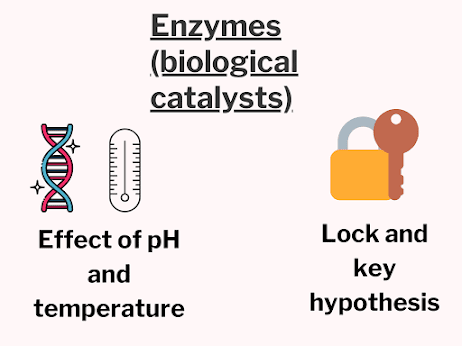Enzymes are those chemical (biological) catalysts that speed up a chemical reaction and they remain unchanged at the end of a reaction.
However, this definition is not enough to meet the requirements of your syllabus about enzymes notes. So, let's start from the very beginning without further introductions.
What are Enzymes?
There are several reactions that require very strong heat to undergo completion. It is not feasible (commercially) to meet all conditions for some reactions.
As a result, catalysts are used to speed up (or alter) these reactions. It is to note that enzymes are organic catalysts usually made up of proteins and their primary function is to speed up slow reactions.
There are several reactions in our everyday life in which enzymes play a very vital role. Let's take a look at some examples to understand the use of enzymes.
The Application of Enzymes:
- In our body, many complex substances are broken down into simpler ones.
For example, glucose is oxidised in a human body to release energy while water and Carbon Dioxide are liberated. This is a very slow reaction but with the help of enzymes, the oxidation of glucose becomes a speedy process.
- Digestion is also a process that involves enzymes.
The food that animals consume consist of large molecules that are either insoluble in water or non-diffusable. These molecules may comprise of carbohydrates, fats and proteins.
With the help of enzymes, these large molecules are converted into smaller and simpler substances which allow them to diffuse across the cell membrane.
For instance, enzymes such as Carbohydrases and Amylase breakdown starch into sugar while lipids breakdown fats into glycerol and fatty acids.
- The synthesis of complex substances from smaller ones also involves enzymes.
For example, protein formation may take place when multiple amino acids are used by the cells. Apart, the enzymes may also be involved in the breakdown of poisonous gases.
These are some examples to show how enzymes are involved in the life of organisms but you should know that specific enzymes only perform specific functions.
For example, protease (enzyme) can also breakdown proteins into amino acids but it cannot breakdown starch or fats. Moreover, enzymes are only produced when they are needed.
Why are Enzymes required in small amounts?
As discussed earlier, enzymes remain unchanged at the end of a reaction. In other words, enzymes are not altered during a chemical reaction.
As a result, the production of enzymes is less because they can catalyse a large number of chemical reactions.
The same enzymes molecule can be utilised for different reactions because it can be used over and over again. This explains why enzymes are required in a minimal amount.
This takes us to another key concept in enzymes notes which is about the "lock and key hypothesis".
The "Lock And Key Hypothesis":
To understand this concept, you should revise the fact that specific enzymes can only catalyse specific chemical reactions which have been discussed with examples above.
Every enzyme has an "active site" on which the substrate fits and get catalysed. What is an active site? Let me explain you.
These are the depressions on enzyme molecules where the substrate (any substance in which an enzyme acts such as fats, proteins and starch) attaches with the enzyme molecule.
When the enzyme and substrate bind together, the reaction takes place and a product is formed. This process is also referred to as the enzyme-substrate complex.
You should also be familiar with the effect of temperature and pH on the enzyme activity. So, it is time to cover this topic as well.
The effect of temperature on enzyme reaction:
Temperature plays a very important role in the activity of an enzyme because enzymes have an optimum (suitable) working temperature.
If the temperature is very low, the enzymes will not display their function properly because, at low temperatures, they are usually inactive.
As a result, less activity is performed.
The increase in temperature will also increase the activity of an enzyme until it reaches its optimum temperature (at which the enzyme activity is the highest).
If the temperature is further increased, it can denature the enzyme. Well, what does this mean? Let me explain this to you!
Since enzymes are usually made up of proteins, high temperature can cause a change in their shape as the three-dimension structure is disturbed.
Read:
Now, let me tell you the effect of pH on the enzyme activity.
Effect of pH on enzyme activity:
The pH refers to the acidity and alkalinity.
Some enzymes show the most activity in slightly acidic conditions while some show their activity in alkaline conditions. Therefore, the enzyme activity is dependent upon pH as well.
However, a massive increase in the pH (either acidity or alkalinity) can completely denature an enzyme.
This ends up our topic about enzymes notes and the important concepts in this topic about enzymes.
Conclusion:
Thank You very much for reading and staying with me till the end. I hope that all your questions about enzymes notes have been answered.
Stay tuned for more useful resources and some of the key points covered in this article are listed below:
- What are enzymes?
- What is the lock and key hypothesis?
- The effect of temperature on enzyme activity
- The effect of pH on enzyme activity


